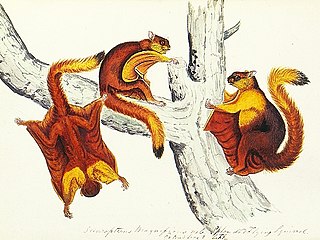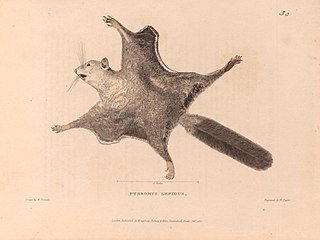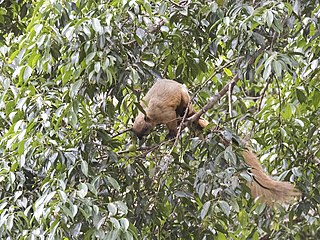Related Research Articles

Squirrels are members of the family Sciuridae, a family that includes small or medium-size rodents. The squirrel family includes tree squirrels, ground squirrels, and flying squirrels. Squirrels are indigenous to the Americas, Eurasia, and Africa, and were introduced by humans to Australia. The earliest known fossilized squirrels date from the Eocene epoch, and among other living rodent families, the squirrels are most closely related to the mountain beaver and to the dormice.

Flying squirrels are a tribe of 50 species of squirrels in the family Sciuridae. Despite their name, they are not in fact capable of full flight in the same way as birds or bats, but they are able to glide from one tree to another with the aid of a patagium, a furred parachute-like skin membrane that stretches from wrist to ankle. Their long tails also provide stability as they glide. Anatomically they are very similar to other squirrels with a number of adaptations to suit their lifestyle; their limb bones are longer and their hand bones, foot bones, and distal vertebrae are shorter. Flying squirrels are able to steer and exert control over their glide path with their limbs and tail.

The southern flying squirrel or the assapan is one of three species of the genus Glaucomys and one of three flying squirrel species found in North America. It is found in deciduous and mixed woods in the eastern half of North America, from southeastern Canada to Florida. Disjunct populations of this species have been recorded in the highlands of Mexico, Guatemala, and Honduras.

Marmots are large ground squirrels in the genus Marmota, with 15 species living in Asia, Europe, and North America. These herbivores are active during the summer, when they can often be found in groups, but are not seen during the winter, when they hibernate underground. They are the heaviest members of the squirrel family.

The eastern chipmunk is a chipmunk species found in eastern North America. It is the only living member of the chipmunk genus Tamias.

Black squirrels are a melanistic subgroup of squirrels with black coloration on their fur. The phenomenon occurs with several species of squirrels, although it is most frequent with the eastern gray squirrel and the fox squirrel. Black morphs of the eastern gray and fox squirrels are the result of a variant pigment gene. Several theories have surfaced as to why the black morph occurs, with some suggesting that the black morph is a selective advantage for squirrels inhabiting the northern ranges of the species, with the black fur providing a thermal advantage over its non-melanistic counterpart.

The grey-bellied squirrel is a species of rodent in the family Sciuridae. It is found in forests, plantations and gardens in Peninsular Malaysia, Thailand, southern Myanmar, southern China (Yunnan) and possibly western Laos. It has been introduced in the Ryukyu Islands in Japan. As suggested by its name, its belly is usually grey, though sometimes reddish on the sides. Depending on subspecies and season, the upperparts are grey, yellowish-olive or reddish.

The spotted giant flying squirrel, also known as the lesser giant flying squirrel, is a species of rodent in the family Sciuridae. It is found in hill and mountain forests at altitudes of 200–4,000 m (660–13,120 ft) in Southeast Asia north to central China and the east Himalayan region, although the northern populations sometimes are regarded as separate species as the grey-headed giant flying squirrel, Chindwin giant flying squirrel and P. marica. Two of these, as well as a few other populations, lack the white spots on the upperparts for which it is named. Although a large flying squirrel, it is a relatively small giant flying squirrel.

Hodgson's giant flying squirrel is a species of rodent in the family Sciuridae. This large flying squirrel lives in Himalayan forests in Asia. Like other flying squirrels, it is nocturnal and able to glide long distances between trees by spreading out its patagium, skin between its limbs.

The Bhutan giant flying squirrel, also known as the Gray's giant flying squirrel or noble giant flying squirrel, is a species of rodent in the family Sciuridae. This species lives in Himalayan forests and it is one of the largest flying squirrels. Like other flying squirrels, it is mainly nocturnal and able to glide long distances between trees by spreading out its patagium, skin between its limbs.

The Indian giant flying squirrel, also called the large brown flying squirrel or the common giant flying squirrel, is a species of rodent in the family Sciuridae. It is capable of gliding flight using a skin membrane stretched between front and hind legs. It is found in mainland Southeast and South Asia, and southern and central China.

The arrow flying squirrel is a species of flying squirrel. It is endemic to Java and Bangka, Indonesia. The population is unknown as it has only been collected from a few localities. It is nocturnal and arboreal and may be found in primary and secondary forest. It is threatened by forest loss due to logging and agriculture and there are no known conservation actions.

The cream-coloured giant squirrel or pale giant squirrel is a large tree squirrel in the genus Ratufa found in forests in the Thai-Malay Peninsula, Sumatra (Indonesia), Borneo and nearby small islands. The species is near threatened and vulnerable to habitat degradation, and it has probably been extirpated in Singapore where the last sighting was in 1995. Reported sightings in Vietnam in 1984 are considered to be dubious.

John L. Koprowski, Dean and Professor, Haub School of Environment & Natural Resources, University of Wyoming, mammalogist, conservation biologist, and leading expert on the ecology and conservation of wildlife, especially squirrels, was born in 1961 in Lakewood, Ohio.
Vagn F. Flyger was a Danish-American wildlife biologist and one of the world's foremost authorities on squirrels. His landmark work was The 1968 Squirrel "Migration" In The Eastern United States. Flyger was also one of the first wildlife biologists to utilize tranquilizer guns in the 1950s when they were first introduced. In the 1960s, he experimented with dart guns in the Arctic on seals, whales and polar bears. However, seeking a field of study that kept him closer to home, Flyger focused most of his remaining research on squirrels.

Marcus Ward Lyon Jr. was an American mammalogist, bacteriologist, and pathologist. He was born into a military family, and demonstrated an early interest in zoology by collecting local wildlife around his father's army posts. He graduated from Brown University in 1897, and continued his studies at George Washington University while working part-time at the United States National Museum (USNM). At the same time, he taught at Howard University Medical School and later George Washington University Medical School. He received his Ph.D. from George Washington University in 1913. In 1919, he and his wife, Martha, moved to South Bend, Indiana to join a newly opened clinic. Prior to moving, Lyon had published many papers on mammalogy, both during and after his tenure at the USNM. In these papers, he had formally described six species, three genera, and one family. Once in South Bend, he began to publish medical studies, too, but continued his work in mammalogy, with a particular focus on the local fauna of Indiana. He published more than 160 papers during his career.
Albert Schwartz was an American zoologist who worked extensively with the herpetofauna of Florida and the West Indies, and later with butterflies. One magazine article once dubbed him as one of the "Kings of West Indian Anole Taxonomy".

Helen Louise Thorington is an American radio artist, composer, performer and writer. She is also the founder of New Radio and Performing Arts (1981), a nonprofit organization based in New York City; the founder and executive producer of New American Radio (1987-1998); and the founder and co-director of Turbulence.org (1996–2016).
Lawrence Richard Heaney is an American mammalogist, ecologist and biogeographer. His research focus is the mammals of the Philippines.
Caroline Thorington is a print maker specializing in lithography. She was born in Winfield, Kansas on March 2, 1943 to Frank and Ellen Miller. She received a B.A. from Kansas State University in 1965 and spent the following year on a fellowship at the Academy of Fine Arts in Munich, Germany, where she learned print making. In 1967 she married zoologist Richard W. Thorington Jr. When he became curator of mammals at the Smithsonian Institution in 1969, she moved with him to the Washington, D.C. area where she has made her home ever since. In 1975 she received a Master of Fine Arts from George Washington University.
References
- ↑ Thorington, Caroline M.; Thorington, Ellen M.; Thorington, Katherine K. (1 June 2018). "Obituary: Richard Wainwright Thorington, Jr. (1937–2017)". Journal of Mammalogy. 99 (3): 741–749. doi: 10.1093/jmammal/gyy045 .
- 1 2 "Richard W. Thorington Jr. '59". Princeton Alumni Weekly. 3 July 2017.
- ↑ "Torch - In Memoriam: Richard W. Thorington, Jr". torch.si.edu.
- ↑ Kelly, John (2017-06-05). "Let's hear it for the Smithsonian's squirrel expert — and for the scientific method". The Washington Post. Retrieved 2023-04-12.
- ↑ "Squirrelologist". Smithsonian.
- ↑ "Richard W Thorington's research works - Smithsonian Institution, DC and other places". ResearchGate.
- ↑ "Squirrels of the World | Johns Hopkins University Press Books".
- ↑ "Hesperopetes thoringtoni Emry & Korth, 2007". Smithsonian Institution.
- ↑ "Artist/Maker: Caroline Thorington - Aberystwyth University School of Art Museums and Galleries". museum.aber.ac.uk.